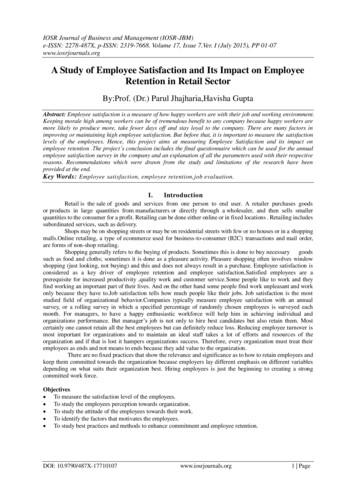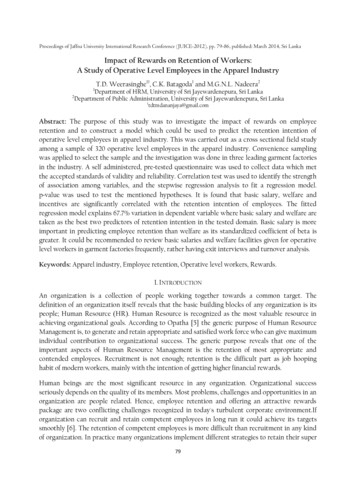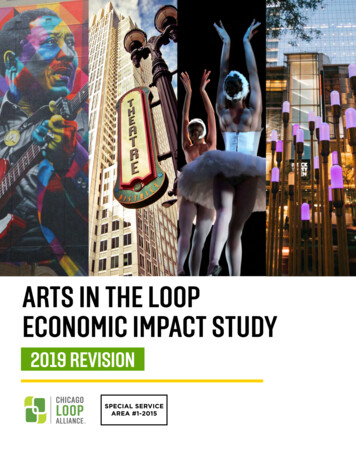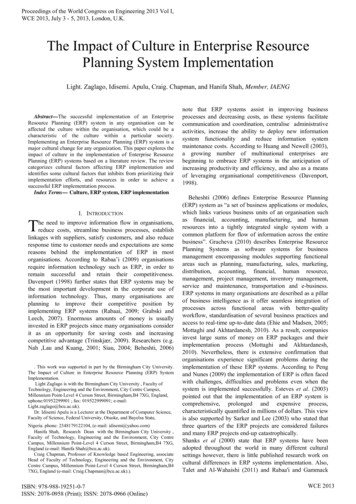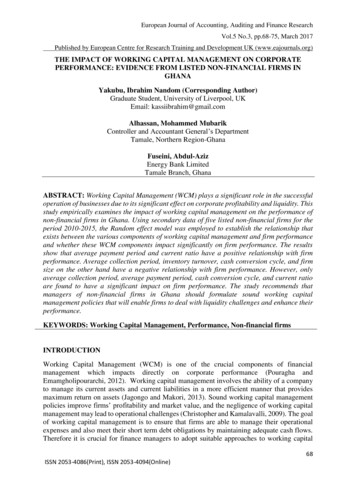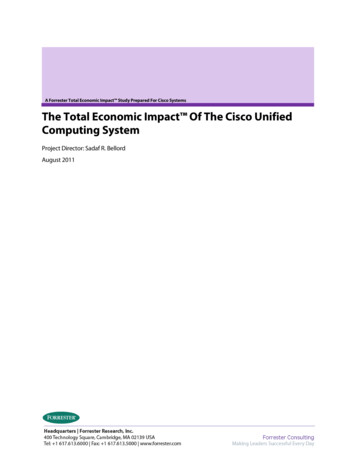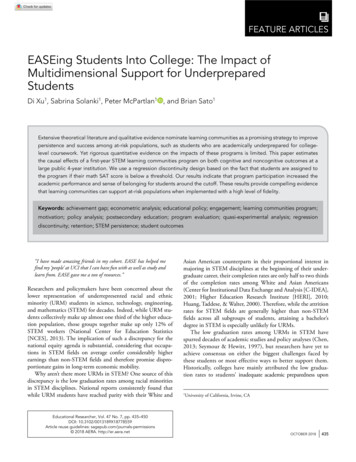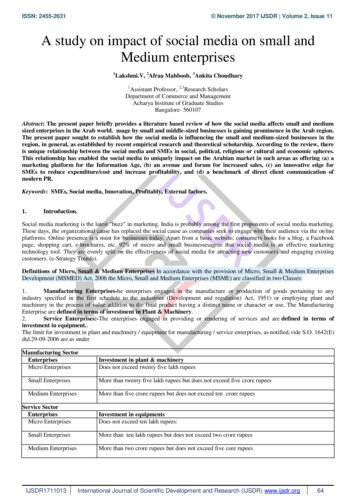
Transcription
ISSN: 2455-2631 November 2017 IJSDR Volume 2, Issue 11A study on impact of social media on small andMedium enterprises1Lakshmi.V, 2Afraa Mahboob, 3Ankita Choudhary1Assistant Professor, 2,3Research ScholarsDepartment of Commerce and ManagementAcharya Institute of Graduate StudiesBangalore- 560107Abstract: The present paper briefly provides a literature based review of how the social media affects small and mediumsized enterprises in the Arab world. usage by small and middle-sized businesses is gaining prominence in the Arab region.The present paper sought to establish how the social media is influencing the small and medium-sized businesses in theregion, in general, as established by recent empirical research and theoretical scholarship. According to the review, thereis unique relationship between the social media and SMEs in social, political, religious or cultural and economic spheres.This relationship has enabled the social media to uniquely impact on the Arabian market in such areas as offering (a) amarketing platform for the Information Age, (b) an avenue and forum for increased sales, (c) an innovative edge forSMEs to reduce expenditure/cost and increase profitability, and (d) a benchmark of direct client communication ofmodern PR.Keywords: SMEs, Social media, Innovation, Profitably, External factors.1.Introduction.Social media marketing is the latest "buzz" in marketing. India is probably among the first proponents of social media marketing.These days, the organizational cause has replaced the social cause as companies seek to engage with their audience via the onlineplatforms. Online presence is a must for businesses today. Apart from a basic website; consumers looks for a blog, a Facebookpage, shopping cart, e-brochures, etc. 92% of micro and small businessesagree that social media is an effective marketingtechnology tool. They are evenly split on the effectiveness of social media for attracting new customers and engaging existingcustomers. (e-Strategy Trends).Definitions of Micro, Small & Medium Enterprises In accordance with the provision of Micro, Small & Medium EnterprisesDevelopment (MSMED) Act, 2006 the Micro, Small and Medium Enterprises (MSME) are classified in two Classes:1.Manufacturing Enterprises-he enterprises engaged in the manufacture or production of goods pertaining to anyindustry specified in the first schedule to the industries (Development and regulation) Act, 1951) or employing plant andmachinery in the process of value addition to the final product having a distinct name or character or use. The ManufacturingEnterprise are defined in terms of investment in Plant & Machinery.2.Service Enterprises:-The enterprises engaged in providing or rendering of services and are defined in terms ofinvestment in equipment.The limit for investment in plant and machinery / equipment for manufacturing / service enterprises, as notified,vide S.O. 1642(E)dtd.29-09-2006 are as underManufacturing SectorEnterprisesMicro EnterprisesInvestment in plant & machineryDoes not exceed twenty five lakh rupeesSmall EnterprisesMore than twenty five lakh rupees but does not exceed five crore rupeesMedium EnterprisesMore than five crore rupees but does not exceed ten crore rupeesService SectorEnterprisesMicro EnterprisesInvestment in equipmentsDoes not exceed ten lakh rupees:Small EnterprisesMore than ten lakh rupees but does not exceed two crore rupeesMedium EnterprisesMore than two crore rupees but does not exceed five core rupeesIJSDR1711013International Journal of Scientific Development and Research (IJSDR) www.ijsdr.org64
ISSN: 2455-2631 November 2017 IJSDR Volume 2, Issue 11Types of Micro and Small Home-based businesses A home-based business is an enterprise in which all or most of the work isperformed at or from the owner-operator's private residence. Home-based business is one of the fastest growing sectors in theeconomy. Common businesses that are operated from home are trade businesses, where general administrative tasks are done athome, with work being completed at various sites. Examples include painters, plumbers and electricians. Many micro-businessesare family operated. Family members will generally have ownership of the business and play a significant role in its day-to-dayoperations. Many publicly-listed companies and franchises started from the humble beginnings of a family-operated business.Some common examples of family businesses include cake shops, restaurants, café, florists, designers, photography and so on.Independent contractors run their own business, and hire out their time to businesses and other organisations as a service. Theirentitlements and obligations differ from an employee in many ways. They own our own business and generally will be able tonegotiate fees and working arrangements. Some examples of independent contractors are builders, caterers and personal trainers.A franchise is an arrangement whereby the originator of a business product or operating system (franchisor) gives a prospectivesmall business owner (franchisee) the right to sell these products and/or use the business operations system on the franchisor'sbehalf. Some key micro-business franchises include food chains, cleaning businesses franchises. E-businesses are businesses thatutilise the internet for business activities, advertising and transactions. With the increase in internet use and popularity, along withrelatively low start-up capital requirements, the emergence of e-businesses has seen a dramatic increase in the past decade. Somee-businesses are solely internet-based, with all communications and transactions completed online. Other businesses use a websiteto support the physical store and products, by providing product information online. Others simply use the internet as anadvertising tool. Marketing The management process through which goods and services move from concept to the customer.Marketing is based on thinking about the business in terms of customer needs and their satisfaction. Marketing differs fromselling because (in the words of Harvard Business School's retired professor of marketing Theodore C. Levitt) "Selling concernsitself with the tricks and techniques of getting people to exchange their cash for your product. It is not concerned with the valuesthat the exchange is all about. And it does not, as marketing invariable does, view the entire business process as consisting of atightly integrated effort to discover, create, arouse and satisfy customer needs." In other words, marketing has less to do withgetting customers to pay for your product as it does developing a demand for that product and fulfilling the customer's needs. Themarketing mix is a familiar marketing strategy tool, which you will probably know, was traditionally limited to the core 4Ps ofProduct, Price, Place and Promotion The 4Ps were designed at a time where businesses sold products, rather than services and therole of customer service in helping brand development wasn‟t so well know. Over time, Booms and Pitner added three extended„service mix P‟s‟: Participants, Physical evidence and Processes, and later Participants was renamed People. Today, it‟srecommended that the full 7Ps of the marketing mix are considered when reviewing competitive strategies. Thus the businessmanuses appropriate marketing mix for his product or services and prepare a marketing strategy using various combinations to reachout the customers. Marketing Strategy An organization's strategy that combines all of its marketing goals into one comprehensiveplan. A good marketing strategy should be drawn from market research and focus on the right product mix in order to achieve themaximum profit potential and sustain the business. The marketing strategy is the foundation of a marketing plan. Life formarketers used to be simpler. He just had a few TV channels, some radio stations, a handful of top magazines and a newspaper ortwo in each market. Reaching consumers was easy by crafting a compelling message. Now there are whole slew of TV channels,millions of web sites and hundreds of thousands of applications. Marketing was never easy, but technology has made it a wholelot tougher. What used to be a matter of identifying needs and communicating benefits now requires to build immersiveexperiences that engage consumers which requires a seamless integration of a whole new range of skills and capabilities. There‟sso much going on in the marketing arena today, everybody is struggling to keep up. At the same time, every marketingprofessional feels pressure to be “progressive” and actively integrate emerging “media” into their marketing program. However,most businesses can be adequately captured by evaluating just three metrics: awareness, sales and advocacy (i.e. customerreferral). This metrics can be achieved through traditional media along with combination of new media called SOCIAL MEDIA.Social Media and Small BusinessesSocial Media Is Changing the Traditional methods of Presence. The traditional techniques of marketing using print andelectronic media along with Internet marketing and lead generation were used to drive traffic to a business and its website. Assearch engine algorithms evolve, website owners have to stay on their toes to make sure their website is constantly updated withrelevant and current information to prevent being devalued in search results. Today, social media like, Facebook pages, Twitteraccounts, and YouTube channels are being seen as sites in their own right to mark the presence. Social Media Allows Businessesto Crowd-source Ideas Before you launch a new product or service, one would like to have some ideas about what people thinkabout it. So by engaging with prospects and customers via social media, one can actually ask the fans and followers what colorsthey prefer or what types of features they want. Thus one can involve consumers in valuable free market research, by asking theiropinions and can help establish credibility by showing that Page 32 their opinions matter. After seeing their ideas becoming areality, business has more than likely just increased their customer base. Social Media Allows to Keep An Eye On Competition Businesses are changing marketing strategies based on information they find in social media feeds from their competitors. Bykeeping an eye on competitors, their strengths and weaknesses can determine their marketing efforts. This gathered informationhelps to implement things that might be needed to improve such as social media campaigns, contests, giveaways or types ofcontent the followers may be responding to the most. Social Media Allows Business to Be More Transparent The process oftaking a prospect to the point of becoming a customer has slowed down somewhat due to consumers‟ awareness. People want tobuy from those companies who have established credibility and who seem to be totally transparent in their advertising campaigns.Social media is changing peoples‟ opinions of businesses. By providing messages that are open, transparent, and helpful, socialIJSDR1711013International Journal of Scientific Development and Research (IJSDR) www.ijsdr.org65
ISSN: 2455-2631 November 2017 IJSDR Volume 2, Issue 11audiences will learn that your business cares about its customers and potential customers. One can position their company as avaluable resource by simply sharing information like advice, tips, or just answering questions about the industry.Social MediaSocial media are computer-mediated technologies that facilitate the creation and sharing of information, ideas, career interestsand other forms of expression via virtual communities and networks. The variety of stand-alone and built-in social media servicescurrently available introduces challenges of definition; however, there are some common features: [1]1.Social media are interactive Web 2.0 Internet-based applications.[1][2]2.User-generated content, such as text posts or comments, digital photos or videos, and data generated through all onlineinteractions, are the lifeblood of social media.[1][2]3.Users create service-specific profiles for the website or app that are designed and maintained by the socialmedia organization.[1][3]4.Social media facilitate the development of online social networks by connecting a user's profile with those of otherindividuals or groups.[1][3]Users typically access social media services via web-based technologies on desktop computers, and laptops, or download servicesthat offer social media functionality to their mobile devices (e.g., smartphones and tablet computers). When engaging with theseservices, users can create highly interactive platforms through which individuals, communities and organizations can share, cocreate, discuss, and modify user-generated content or pre-made content posted online. They introduce substantial and pervasivechanges to communication between businesses, organizations, communities and individuals. [4] Social media changes the wayindividuals and large organizations communicate. These changes are the focus of the emerging field of technoself studies. Socialmedia differ from paper-based media (e.g., magazines and newspapers) or traditional electronic media such as TV broadcasting inmany ways, including quality,[5] reach, frequency, interactivity, usability, immediacy, and permanence. Social media operate in adialogic transmission system (many sources to many receivers). [6] This is in contrast to traditional media which operates under amonologic transmission model (one source to many receivers), such as a paper newspaper which is delivered to many subscribersor a radio station which broadcasts the same programs to an entire city.Some of the most popular social media websites are Baidu Tieba, Facebook (and its associated FacebookMessenger), Gab, Google , Instagram, LinkedIn, Pinterest, Reddit, Snapchat, Tumblr, Twitter, Viber, VK, WeChat, Weibo, WhatsApp, Wikia, and YouTube. These social media websites have more than 100,000,000 registered users.In America, a survey reported that 84 percent of adolescents in America have a Facebook account. [7] Over 60% of 13 to 17-yearolds have at least one profile on social media, with many spending more than two hours a day on social networkingsites.[8] According to Nielsen, Internet users continue to spend more time on social media sites than on any other type of site. Atthe same time, the total time spent on social media sites in the U.S. across PCs as well as on mobile devices increased by 99percent to 121 billion minutes in July 2012 compared to 66 billion minutes in July 2011. [9] For content contributors, the benefitsof participating in social media have gone beyond simply social sharing to building a reputation and bringing in careeropportunities and monetary income.[10]Observers have noted a range of positive and negative impacts of social media use. Social media can help to improve individuals'sense of connectedness with real or online communities and social media can be an effective communication (or marketing) toolfor corporations, entrepreneurs, nonprofit organizations, including advocacy groups and political parties and governments. At thesame time, concerns have been raised about possible links between heavy social media use and depression, and even the issuesof cyberbullying, online harassment and "trolling". Currently, about half of young adults have been cyberbullied and of those, 20percent said that they have been cyberbullied regularly. [11] Another survey was carried out among 7th grade students in Americawhich is known as the Precaution Process Adoption Model. According to this study, 69 percent of 7th grade students claim tohave experienced cyberbullying and they also said that it is worse than face to face bullying.2.Literature review1)Social media is the interaction among people in which they create, share or exchange information and ideas in virtualcommunities and networks. Andreas Kaplan and Michael Haenlein define social media as "a group of Internet based applicationsthat build on the ideological and technological foundations of Web 2.0, and that allow the creation and exchange of usergenerated content. Furthermore, social media depend on mobile and web-based technologies to create highly interactive platformsthrough which individuals and communities share, co-create, discuss, and modify user-generated content. They introducesubstantial and pervasive changes to communication between organizations, communities, and individuals. Social media differfrom traditional or industrial media in many ways, including quality, reach, frequency, usability, immediacy, and permanence.There are many effects that stem from internet usage. According to Nielsen, internet users continue to spend more time withsocial media sites than any other type of site.2)Social media is the collective of online communications channels dedicated to community-based input, interaction,content-sharing and collaboration. Websites and applications dedicated to forums, microblogging, social networking, socialbookmarking, social curation, and wikis are among the different types of social media.3)Social media broadly defined consists of any online platform or channel for user generated content. By this definition,for example, WordPress, Sharepoint, and Lithium qualify as social media, as do YouTube, Facebook Page 44 and Twitter. SocialIJSDR1711013International Journal of Scientific Development and Research (IJSDR) www.ijsdr.org66
ISSN: 2455-2631 November 2017 IJSDR Volume 2, Issue 11media more narrowly defined includes only channels for user-generated content, as distinguished from platforms, which arereferred to as social technologies. By this definition, for example, YouTube, Facebook, and Twitter are social media, andWordPress, Sharepoint and Lithium are social technologies. Joe Cothrel – Lithium Technologies, Inc.4)Social media is digital content and interaction that is created by and between people. Sam Decker – Mass Relevance5)Social media is a shift in how we get our information. It used to be that we would wait for the paper boy to throw ournews on the doorstep (or into the flowers) and we‟d read the paper, front to back, with our morning coffee before going to work.Now we get information, 24/7 and on the fly, from anywhere. In the more traditional senses, online, on our phones, and throughthe social platforms. Social media allows us to network, to find people with like interests, and to meet people who can becom efriends or customers. It flattens out the world and gives us access to people we never would have been able to meet otherwise.Gini Dietrich – Arment Dietrich, Inc.6)All the traditional media print, broadcast, search, and so on provide platforms for delivery of ads near and aroundrelevant content. Social media are platforms for interaction and relationships, not content and ads. This is quite similar to whatTed McConnell, General Manager-Interactive Marketing and Innovation at Procter & Gamble Co. likes to say about social media.Bryan Eisenberg – Author of Waiting for Your Cat to Bark (Affiliate link).7)Markets have become conversations. Social media are the online platforms and locations that provide a way for people toparticipate in these conversations. For individuals it is a way to connect and share content with Page 45 friends and like-mindedpeople. For businesses it‟s a way to tap into what people are saying about your brand, your product and/or your service,participate in the conversations, be open to new ideas and then use these insights to make better business decisions. Sally Falkow.8)Social media is people‟s conversations and actions online that can be mined by advertisers for insights but not coercedto pass along marketing messages. It‟s the new form of media that does not exist until it happens and that cannot be bought byadvertisers to carry their messages. Dr. Augustine Fou – Marketing Science Consulting Group, Inc.9)Social media is the tools, services, and communication facilitating connection between peers with common interests.Chris Garrett – Chrisg.com10)Social media are the online technologies and practices that people use to share content, opinions, insights, experiences,perspectives, and media themselves. They are media for social interaction. Howard Greenstein – Social Media Club-NYC11)Social media is an ever-growing and evolving collection of online tools and toys, platforms and applications that enableall of us to interact with and share information. Increasingly, it‟s both the connective tissue and neural net of the Web. AnnHandley – Marketing Profs, Author with C.C. Chapman of Content Rules (Affiliate link)12)Social media is a reflection of conversations happening every day, whether at the supermarket, a bar, the train, thewatercooler or the playground. It just allows for those conversations to reach a broader audience due to digital being a megaphonefor scale Sarah Hofstetter –13)Social media is online text, pictures, videos and links, shared amongst people and organizations. Dave Kerpen –Likeable Media14)Social media is not one thing. It‟s five distinct things: It‟s a strategic tool for uncovering business insights. It‟smanaging the influencers who are driving the conversation around your brand. It‟s marketing that provides value and turnscustomers into evangelists. It‟s a critical component customer care. It‟s transforming your organization to meet thetransparency and humanity customers now expect of brands. Adam Kleinberg – Traction15)Social media is digital, content-based communications based on the interactions enabled by a plethora of webtechnologies. Rebecca Lieb, author of The Truth About Search Engine Optimization (Affiliate link).16)Marketing is a crucial activity for the survival and success of a business. Businesses today have more marketingopportunities than ever (Bresciani & Eppler, 2010).17)In small businesses, marketing relies heavily on word of mouth recommendations for customer acquisition (Stokes &Lomax, 2002).18)Today‟s economy, distinguished by relationships, technology, and networks, favors some of the characteristics of SMEs(Walsh & Lipinski, 2009).19)Social media enables companies to network with customers in order to build relationships and achieve a betterunderstanding of customer needs. Businesses want their message to reach as many people as possible.20)To maximize this reach, a business must have a presence where customers are hanging out. Increasingly, they arehanging out on social networking sites (Halligan, Shah, & Scott, 2009). Social media provides multiple opportunities for smallbusinesses to market to consumers and build closer and more profitable relationships. However, small businesses still struggle toreach customers.Research methodology1.Title of the study“ A study on impact of social media on Small and Medium enterprises “2.Research methodologyThe study is purely based on secondary source of data collection. The details are collected from the websites books and journals.3.a.b.c.d.4.Objectives of the studyTo study the concept of SMEsTo study the concept of social MediaTo Study the impact of Social media in marketing the goods.To find the suggestions for the negative impact of social media on SMEsLimitations of the studyIJSDR1711013International Journal of Scientific Development and Research (IJSDR) www.ijsdr.org67
ISSN: 2455-2631 November 2017 IJSDR Volume 2, Issue 11he limitations relevant to the research include:1. Because a variety of companies exist, it was unfeasible for the scope of this research to cover every industry.2. The limitations of the collected data make it difficult to make generalizations across industries, companies, and locations.3. The research lacks a comparison between the practices of a company recognized for using social media marketing successfull yand a company using it less successfully.4. Impact Of social Media4.1 The Positive & Negative Impact of Digital Media on BusinessModern media is no longer confined to a television or radio show, newspaper or advertisement. Instead, today's media -- from textto video and sound -- can be saved and shared electronically, using everything from desktop computers to small mobile devices.This electronic dissemination of media has had a powerful impact on the way people communicate for personal reasons, schooland even business. However, digital media has not had only a positive impact on business.Faster InformationThanks to digital media, companies can get their information out to the public faster than ever. Instead of printing inserts andwaiting for the Sunday paper to announce their sales, companies now can let the world know about an exciting promotion throughemail, social networking, their websites and Internet ads. However, digital media can spread bad information about a business justas fast as it can spread good. A video or camera taken with a cell phone or a Facebook status update featuring a company secret orfaux pas can go viral within minutes, leaving a business's reputation damaged when business before digital media would havebeen able to clear up the mess long before it went public.Greater ReachDigital media means businesses can reach more customers than ever before. A simple promotion featuring a giveaway or a freebiecan earn a business hundreds or thousands of Facebook fans and email and text message subscribers, meaning that the businesscan send a message to these consumers with just a touch of a button. However, digital media also means that those consumers canreach back. Through negative comments to your Facebook page and other social networking sites, like Twitter and your blog,customers can use digital media to take a complaint that would have otherwise been between the two of you world wide.TechnologyUsing digital media means using new technology both to create and support the media. New technology can be an asset for yourbusiness. When you adopt smartphones and laptops in order to use digital media, you also can positively influence other areas ofyour business. For example, such mobile technology makes communication among employees much easier. However, newtechnology is expensive, and sometimes it does not have the positive effect its champions think it will have. For example,"Information Week" notes that a number of companies gave its employees home computers when the Internet first becamepopular hoping that those employees would be a positive influence for the company online. However, the program really endedup causing support and tax problems for the companies and employees.OptionsThanks to digital media, businesses now have many more options that they can choose from when seeking to get word out abouttheir businesses. Instead of choosing among a TV or radio commercial or a print advertisement, they can now create media that isa combination of audio, visual, text and interactive media. This mixed media can appeal to a larger audience with differentiatedpreferences. However, it is also more costly to keep up with the ever-changing technology and may require the creation of newstrategists who can think and create digital.4.2 Negative Effects of Social Media on BusinessBurden of the Marketing ShiftBusiness marketing now involves personal engagement with customers; campaigns that do not invite consumer interaction riskbeing unsuccessful. While social media-based marketing can be used effectively, businesses that are used to providing a one-sidedsell must now learn how to develop a relationships with people buying their product. Instead of releasing statements aboutproduct lines, companies have to develop stories that promote the culture of the product instead of simply outlining its particularbenefits.Increased Customer PowerIn the days before social media, negative company experiences might stay within an individual's circle of friends; now, stories ofbad customer service and disappointing products can run quickly through social media networks. It has become more difficult forcompanies to contain its negative publicity. The upside is that as much as bad publicity spreads more quickly, good publicityspreads more quickly as well.Tracking Negative or Misleading StatementsSocial media is an enormous conversation everyone is invited to join; with all that talk, it's difficult for businesses to trackstatements about their brand that are negative or even defamatory. Companies have the added burden of tracking statements andIJSDR1711013International Journal of Scientific Development and Research (IJSDR) www.ijsdr.org68
ISSN: 2455-2631 November 2017 IJSDR Volume 2, Issue 11responding when necessary; the response, however, might be of limited effect if the negative statement has already made thesocial media rounds.Accidental Release of Confidential InformationIndividuals with inside knowledge of the company might inadvertently blurt out confidential information, damaging thecompany's competitive advantage. Before social media, a letter sent to the wrong address or even an email that ended up in thewrong inbox could be retrieved and the information kept under wraps. In the world of social media, the sheer numbers mean thatonce confidential information is out, it's out.Unauthorized Employees Speaking on Company's BehalfIt's difficult for companies to monitor employee social media activity and prevent them from speaking on company matterswithout authorization. In the era of engagement, companies might strive for employees to have the ability to assert theirpersonalities online; however, this freedom comes with the risk that even a well-meaning social media post about a company'sperceived objectives and direction can damage the company's reputation or challenge the company's assertions to investors.4.3 The High-Level Business Impact of Social MediaCustomer Relationship ManagementTom Funk writes in “Social Media Playbook for Business: Reaching Your Online Community with Twitter, Facebook, Linke
small business owner (franchisee) the right to sell these products and/or use the business operations system on the franchisor's behalf. Some key micro-business franchises include food chains, cleaning businesses franchises. E-businesses are businesses that utilise the internet for bu
